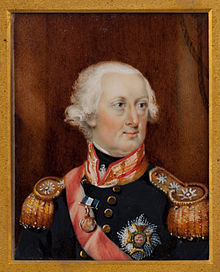Charles Henry Knowles
| Sir Charles Henry Knowles, Bt | |
|---|---|
 |
|
| Born | 24 August 1754 Kingston, Jamaica |
| Died | 28 November 1831 (aged 77) |
| Allegiance | United Kingdom of Great Britain and Ireland |
| Service/ |
Royal Navy |
| Years of service | 1768–1831 |
| Rank | Admiral |
| Commands held |
HMS Supply HMS Minorca HMS Porcupine HMS San Miguel HMS Daedalus HMS Edgar HMS Goliath HMS Britannia |
| Battles/wars |
Battle of St. Lucia Battle of Grenada Relief of Gibraltar Battle of Cape St Vincent |
| Awards |
Naval Gold Medal Knight Grand Cross of the Order of the Bath |
| Relations | Charles Knowles (father) |
Sir Charles Henry Knowles, 2nd Baronet, GCB (24 August 1754 – 28 November 1831) was an officer of the Royal Navy, who saw service during the American War of Independence, and the French Revolutionary and Napoleonic Wars, eventually rising to the rank of Admiral. Highly intellectual, he authored a number of signal books and had the chance to put his ideas into practice during his naval career. Knowles was at times beset by problems with discipline aboard his ships, often due to large proportions of raw recruits and untrained seamen. This may have been a factor in his rocky relationship with his superior, Sir John Jervis, which eventually led to Knowles's retirement from active service after the Battle of Cape St Vincent, and his concentration on scholarly studies of the issues affecting the naval service.
Knowles was born at Kingston, Jamaica on 24 August 1754, the second son of the Governor of Jamaica Admiral Sir Charles Knowles and his wife Maria Magdalena Theresa de Bouget. He received his initial education at Eton College circa 1764–6, and then subsequently at Glasgow and Edinburgh. He joined in navy in 1768 as a midshipman aboard the 36-gun frigate HMS Venus, which was then serving in the English Channel under the command of Captain Samuel Barrington. He was then aboard the Spithead guard ship the 74-gun HMS Lenox under Captain Robert Roddam, before joining the 32-gun HMS Southampton under Captain John MacBride, where he served at Plymouth and in the Channel.
...
Wikipedia
